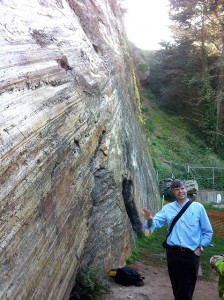Resor’s Study Seeks Better Understanding of How Earthquakes Occur

A new study designed to give scientists a better understanding of how earthquakes occur by studying ancient faults long after the quakes are over will be led by a Wesleyan faculty member and involve at least two of his students.
Phillip Resor, assistant professor of earth and environmental sciences, received a $246,728 NSF (National Science Foundation) grant for his study titled “Three Dimensional Characterization of a Pseudotachylyte-bearing Fault.” The grant includes funding for one thesis student for each of the next two years; Wesleyan has contributed additional funding for a second student in 2012. The study will also establish a new collaboration between Wesleyan and scientists from the Istituto Nazionale di Geofisica e Vulcanologia (INGV), a world-renowned research institute in Italy.
The study is designed to improve the understanding of earthquakes and their effects, one of the primary goals of the National Earthquake Hazard Reduction Program. Specifically, Resor and his students will be examining faults that were once located more than 4 miles below the earth’s surface, where most large earthquakes begin. The conditions were so extreme at these depths that the walls of the faults actually melted due to frictional heating, creating a fault rock geologists call pseudotachylyte. The study will use high-resolution x-ray computed tomography, similar to medical imaging technology, to look inside these faults for evidence of ancient quakes and gain new insights into their underlying causes.
“In order to produce an earthquake slip must be rapid enough to produce high-frequency waves and sufficiently large to be detectable at the surface,” Resor says. “But seismology has been unable to resolve some key issues in earthquake mechanics. For example, earthquake slip is associated with unstable frictional sliding, wherein the strength of the fault during the earthquake is lower than the strength before the event, leading to a net release of energy. Seismologists have been unable to resolve the strength of the fault during slip and the physical and chemical processes responsible for this strength reduction.”
Resor and his students will seek their answers using the imaging equipment to examine natural and experimental fault surfaces to quantify surface roughness, frictional contact area, and pseudotachylyte fault rock thickness.
“Pseudotachylytes are generally considered the only unequivocal evidence of earthquake slip velocities that is preserved in fault zones,” Resor says.
The study builds on a previous study that Resor did with Vanessa Meer ’06 which quantified the geometry of a fault surface and its effect on slip. Current students, Kate Shervais ’13 and Sarah Bessey ’14, will both be working on the project this summer, including fieldwork in Italy.
The results of this study will have direct connections to courses Resor teaches at Wesleyan including, Dynamic Earth (EES101), Structural Geology (EES223) and Field Geology (EES225). “We actually visit outcrops with frictional melts in Lyme, Connecticut, in Field Geology, so it will be great to have the connection between that field site and our active research,” Resor says.
The study will be concluded in 2014.

